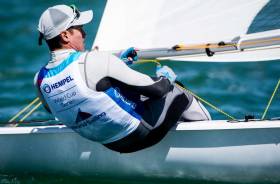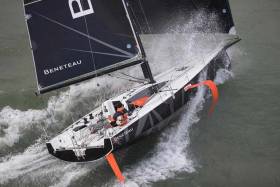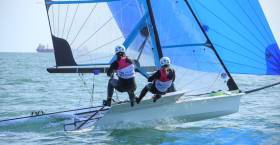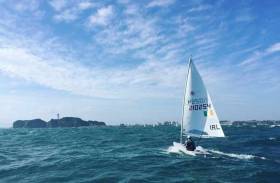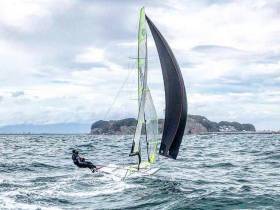Displaying items by tag: olympic sailing
Fight is On for Irish Olympic Sailors as Qualification Route to Tokyo 2020 is Finalised By World Sailing
World Sailing and the IOC have finally concluded the Tokyo 2020 Olympics qualification system, including continental qualification.
The basic qualification system is one spot in each event for the host nation, then 40% of the national spots were awarded at the Aarhus 2018 Worlds.
The final qualification event is the Olympic Classes World Cup event in Genoa, Italy, from 13 to 19 April 2020. World Sailing will then reallocate all unused quota places on the 10 June 2020.
Ireland failed to qualify in any of the five of the ten Olympic events at the Aarhus 2018 Worlds, and thus the fight is well and truly on to secure Irish places at Tokyo 2020. Detail of the Irish team is here.
Once this has been achieved, the focus will be on who will actually represent Team IRL in each sailing event at the Tokyo 2020 Games.
Deciding this is a function of trials set out recently by Irish Sailing.
In the meantime, Irish sailing team members are preparing to contest the Trofeo Princesa Sofia in Palma next month. In a hopeful sign already this season, there have been some bright performances by Finn Lynch in the Laser in Miami when he became the first Irishman to make a World Cup Laser Medal Race.
Afloat's Tokyo coverage on this one handy link here
How Will an Irish Olympic Two-Person Offshore Campaign for France 2024 take shape?
A woman. A man. Three days and two nights together at sea. Racing in a cramped 30ft boat. Under 24-hour surveillance. It sounds like the latest pitch for a Reality TV show. Arguably, it is. But it’s also the new Olympic sailing challenge writes W M Nixon.
However, the real speculation has only just begun about the eventual planned re-introduction of keelboats to the Olympic sailing lineup in 2024. Behind the social media noise, it’s mainly about bringing proper offshore racing to the five-ring circus. But as soon as it was revealed that the changes would involve bringing in a keelboat and dumping the veteran Olympic Finn, the general fixation seemed to be about the boats rather than the people and the sport and the audience impact.
There has been all the understandable grief inspired by the demise of the single-handed Finn’s Olympic role. Many see her as the ultimate single-hander, best expressed through Olympic status. And as well there has been the throwback from Star keelboat adherents, who still dream of their quaint machines being re-aligned back into the Olympic gallery.
 “Quaint machines”. What is it about the ancient yet ever up-dated International Star? As soon as it was revealed that a keelboat would re-appear in the 2024 Olympics boat lineup, there was a clamour of support to bring back the Star
“Quaint machines”. What is it about the ancient yet ever up-dated International Star? As soon as it was revealed that a keelboat would re-appear in the 2024 Olympics boat lineup, there was a clamour of support to bring back the Star
Inevitably, social media seems to have been immediately swamped by people trying to shoot from the hip with instant opinions. Yet they’ve often managed to shoot themselves in the foot instead of hitting any meaningful target.
But despite this tsunami of snap opinions, we should be a bit more patient, and try to get to the real story. Instead of seeing it as a curious attempt to introduce a less athletic type of boat back into the sailing Olympiad, we should realise that it is all part of sailing’s continuing struggle to maintain its position as an Olympic sport in the first place.
Now admittedly with sailing firmly in place for 2020 at Tokyo, and with the 2024 Olympiad in Paris and the sailing events at Marseilles in sailing-mad France, the position is secure for the next two Olympiads. But beyond that…..?
It all comes down to global viewing numbers. If the public worldwide aren’t buying arena tickets or tuning into the images of a particular Olympic sport, then the International Olympic Committee will begin to query whether or not that sport should be in the Olympic Games in the first place.
Other underlying themes include whether or not the sport in question is truly global in its reach, effortlessly transcending national, racial and economic boundaries. But ultimately the key point is the level of human interest and spectator involvement that the sport engenders.
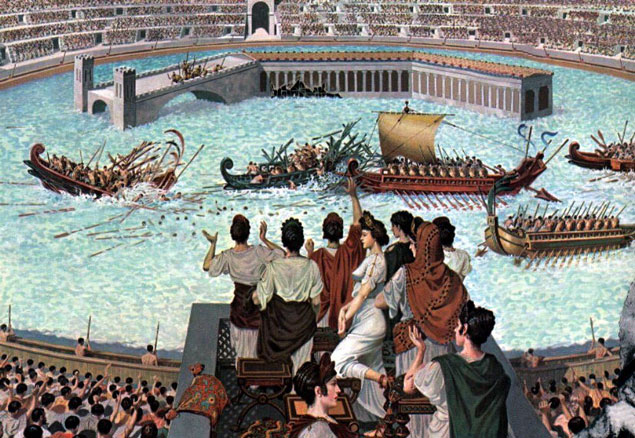 Sailing as a stadium sport in a staged naval battle for entertainment purposes in the Colosseum in Rome. Unfortunately for modern purposes, such encounters involved unacceptable levels of fatality….
Sailing as a stadium sport in a staged naval battle for entertainment purposes in the Colosseum in Rome. Unfortunately for modern purposes, such encounters involved unacceptable levels of fatality….
Thankfully, we no longer have to rely on sailing reinventing itself as some sort of traditional-style stadium sport. Stadiums develop around athletic contests and team games in a natural organic progression which stems from the immediate human interaction between physically present sportsmen and nearby spectators. But any attempts to make sailing an arena event other than by the electronic means of a virtual stadium seem doomed to failure, for the water and the boats keep getting in the way, and sailing does not lend itself to circuit courses.
That’s how it is for the spectating and viewing public. But as sailors, we start from the opposite end of the spectrum – the boats. We always liked to think the Finn singlehander was the ultimate Olympic sailing experience. There was no doubting this very special boat’s unrivalled athletic demands. And she comes with the kind of special pedigree beloved of boat-nuts.
The story of the Finn is a perfect nugget of sailing history. After World War II, the UK hosted the first post-war Olympics in 1948 in London, with the sailing at Torquay. With the massive disruption of the war, the previous Olympics had been all of 12 years earlier, in 1936 in Berlin, with the sailing at Kiel on the Baltic.
 The O-Jolle was specially designed to be the single-hander for the 1936 Olympics in Germany. There are still about 500 of them sailing in the Netherlands, Germany, Austria, Italy and Switzerland, and they feature in the Vintage Olympic Classes Yachting Games
The O-Jolle was specially designed to be the single-hander for the 1936 Olympics in Germany. There are still about 500 of them sailing in the Netherlands, Germany, Austria, Italy and Switzerland, and they feature in the Vintage Olympic Classes Yachting Games
Only four classes had taken part in Kiel, three of them keelboats including the eternal Star. But the singlehander (and only dinghy) was a German design, the una-rigged O-Jolle specially created for the 1936 Olympics, with the Gold Medallist being the Dutch sailor Daan Kagchelland.
A dozen years later, with the world still only partially emerged from the devastation of global conflict, the British hosts accepted that the boat lineup should reflect post-war austerity, but were understandably reluctant to include their recent enemy Germany’s useful O-Jolle. And in face of a demand for an additional two-handed class which was less complex than the Star, they rejected some attractive existing Continental dinghy designs and the International 14 (possibly because it was a restricted class rather than a One-Design), and plumped instead for a slim and attractive new 26ft keelboat, the Swallow.
The other boats reflected established and new trends, as they retained the 36ft International 6 Metre with her crew of five and the International Star with her crew of two, but added the increasingly-popular three-man International Dragon. So keelboats were still very much in the ascendant, as the only dinghy was the new single-hander.
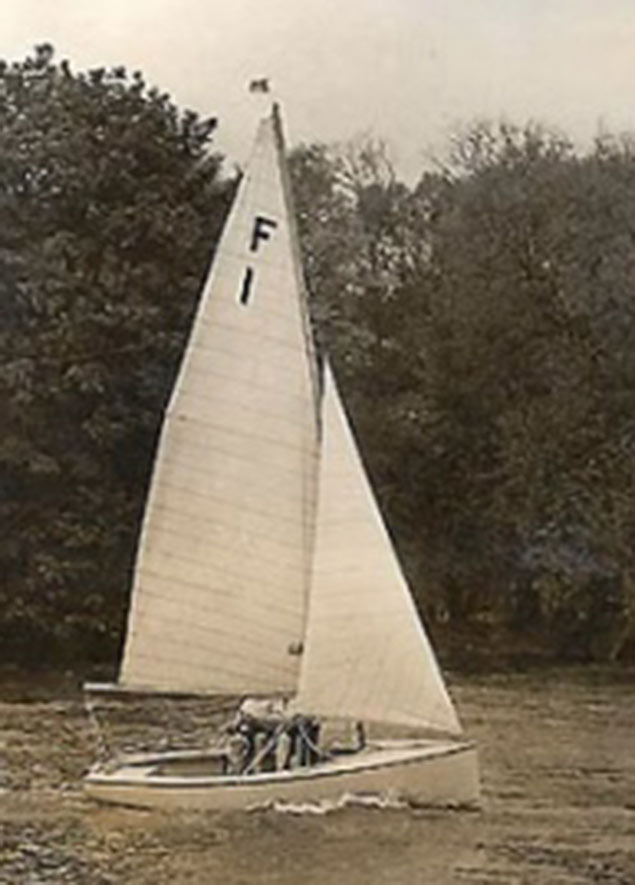 The first Firefly. An excellent two-hander, she was less than ideal as the single-hander at the 1948 Olympics at Torbay
The first Firefly. An excellent two-hander, she was less than ideal as the single-hander at the 1948 Olympics at Torbay
At first glance, they made a weird choice, as it was the 12ft sloop-rigged Firefly. This Uffa Fox-designed planing dinghy (first sailed in 1938) was now being mass-produced in a hot moulding process (“baked like a waffle” they used to say) at Fairey Marine, thereby taking up production potential from the former wartime levels at Fairey Aviation. It was a patriotically popular choice in the heartlands of the British marine industry, but as a single-hander, it would have been very few people’s first selection.
Nevertheless, Denmark’s most dedicated dinghy single-hander, a somewhat introverted young man called Paul Elvstrom, won the Gold Medal in the Firefly. And then he went on to win the single-handed Gold Medal in the next three Olympics, but they were to be sailed in a boat which came to epitomize the Olympic sailing ideal.
The 1952 Olympics were scheduled for Helsinki in Finland, and the Finnish organisers and the International Olympic Committee must have gone to work on the challenge of selecting a more appropriate single-hander even as the sailing at Torquay was underway. For by 1949 a Swedish canoe designer called Rickard Saarby had created a 4.5 m (14ft 9ins) powerful yet classic one-sailor hull with a una rig. It came to be called the Finn in honour of the hosts. And when it ceases to be an Olympic Class after the 2020 Tokyo Olympics, this admittedly challenging yet much-loved boat will have been the longest-serving Olympic dinghy, having performed at 18 Olympics on the trot.
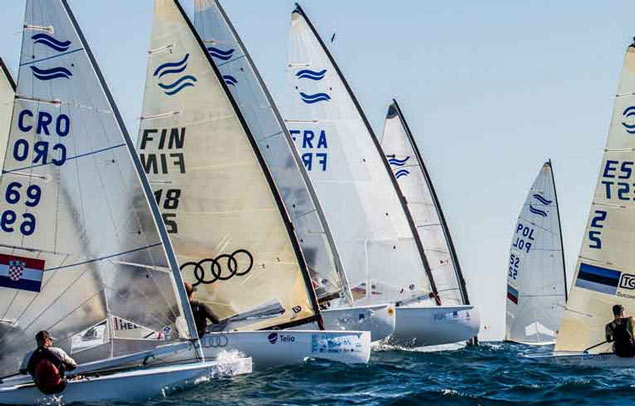 The Olympic Finn in classic action. For sailors, they were the ultimate Olympic ideal. But for ordinary spectators, for all that you can see of the helmsman’s individuality, they might as well be sailed by robots
The Olympic Finn in classic action. For sailors, they were the ultimate Olympic ideal. But for ordinary spectators, for all that you can see of the helmsman’s individuality, they might as well be sailed by robots
That’s not quite as sensational as it sounds, as the other four classes at Helsinki in 1952 were still keelboats – the inevitable Star, the Dragon, the new International 5.5 Metre, and the International 6 Metre. For modern sailors, and the previous generation too, come to that, this must seem like the lineup for the Jurassic Sailing Olympics. Yet such it was, and it didn’t look so different in 1956 in Melbourne, Australia, when they dropped the big International 6 Metre, and introduced the first two-man dinghy.
But although there were now recognizably modern boats on the international scene, the powers-that-be selected a primitive hard-chine machine called the International 12 Square Metre Sharpie. Originally designed in Germany in 1931, she set a gaff/gunter rig and was usefully popular in certain countries which at the time had considerable influence in the decisions of Olympic sailing.
 One of the crazier Olympic choices – the International 12 Square Metre Sharpie was the first two-man “dinghy” in the Olympics. It was used just once – in 1956
One of the crazier Olympic choices – the International 12 Square Metre Sharpie was the first two-man “dinghy” in the Olympics. It was used just once – in 1956
It wasn’t until the 1960 Olympics in Rome, with the sailing at Naples, that a modern two-man dinghy made the Olympic lineup. This was the Flying Dutchman, which admittedly was nearly 20ft long, but she was so good she could plane going upwind, and at Naples in 1960 she saw Ireland’s first-ever first place in an Olympic race for Peter Gray and Johnny Hooper of Dun Laoghaire. And then in 1980, she brought Ireland’s first medal, a Silver at the Games in Russia for David Wilkins of Malahide and Jamie Wilkinson of Howth. So there was some sadness in Ireland when the FD’s Olympic career came to an end after the 1992 Games.
 The Flying Dutchman, a two-handed dinghy for real Olympians
The Flying Dutchman, a two-handed dinghy for real Olympians
This meandering tale of which boats are in or out in the Olympic scramble can be of enormous – indeed, obsessive - interest to sailing folk. But such things are scarcely comprehended by other athletes, who see sailing as primarily a vehicle activity, arguably not a sport really at all, in which the actual vehicle and its colourful history is of little or no interest.
As to what is required to obtain sport in such vehicles, other athletes can become very bewildered, as sailing is a “sport” in which the participants seem to spend much of their time sitting down, albeit in the most uncomfortable possible way. On top of that, they’re often sitting in such a way that you can’t easily see their faces, and it’s the registering and relating to extreme facial expressions which give other athletes - and more importantly the spectators - a proper sense of connection. For although sailors just love the image of a well-trimmed Finn thrashing to windward, most of the time you can only see the back of the helmsman’s head, and as far as spectator human interest is concerned, the Finn might as well be sailed by a robot.
Thus the developing Sailing Olympics seek to emphasise human interest and personal interaction. That, and witnessing extreme physical achievements. As in: Really Extreme Physical Achievements. Consequently, in the sailing community at large, not only have the instant commentators missed the real point of the reintroduction of keelboats, they’ve also missed the fact that the latest decision of World Sailing’s Equipment Committee at the WS Annual Conference in Florida (with a large and busy Irish contingent) has made sure that at the Paris Olympics, the range of sailing machines and boats will go from one extreme of displacement to another.
The extremes of sailing begin with the almost-no-displacement “vehicle” in the Mixed Kiteboarding Event, with a foiling board fitted with RAM-air (foiling kite) certainly providing extreme physical achievement – arguably to stunt level.
 Minimal displacement…..foiling kite-surfing rates high on the sailing sports spectacular rankings
Minimal displacement…..foiling kite-surfing rates high on the sailing sports spectacular rankings
Then in between, there’ll be a still-to-be-decided Mixed Two Person Dinghy of non-foiling displacement form with main, jib and spinnaker – Paddy Boyd, one of many delegates from Ireland at the Florida conference, reckons it will keep the 470 in the lineup, for all that the design has been around since 1963.
But then we’re into totally new territory – the inclusion of a Mixed Two Person Offshore Keelboat. If this seems to be a return of keelboats to Olympic Sailing, perish the thought. For with this particular class it’s definitely not Olympic Sailing as we know it. It’s arguably a new event altogether, as the backbone of this keelboat debut will be an offshore race which will be shaped to fit the prevailing conditions such that it will last three days and two nights, making it far and away the longest continuous event in the Olympic Games.
Heaven help the race Officers at Marseilles in 2024 trying to predict Mediterranean weather with sufficient accuracy to ensure a race of just this length in time but no longer. Yet Cathy MacAleavey – who’s on the Equipment Committee which set the parameters of the new boat – says that is the aspiration.
As to the boat which will be used, the length overall will be between 6 metres and 10 metres, definitely non-foiling, and currently talked of as sloop rig with spinnaker, but Cathy reckons they’ll have settled on a genniker by the time the details are being finalized.
Needless to say, the human interest aspect immediately focuses on the fact that it will be a man and a woman together for 60 hours in the confines of a boat which could be as commodious as a Figaro 2, but equally it could be as cramped as a Minitransat 6.5.
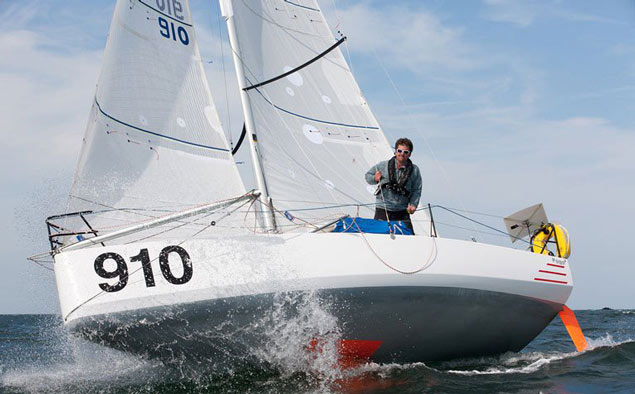 Tom Dolan with his Ministransat 650. With a proposed size range between 6 and 10 metres, the possibility of this small size of boat in the Olympic offshore race has to be considered
Tom Dolan with his Ministransat 650. With a proposed size range between 6 and 10 metres, the possibility of this small size of boat in the Olympic offshore race has to be considered
There’ll be miniature cameras everywhere on board, and continuous transmission from all boats while the race is in progress. It may seem intrusive, but that’s the way the Internet is now. The inter-personal chemistry and immediate visual access to interaction with other boats will be everything, and Internet popularity will play a key role in keeping Olympic sailing on the road.
Far from lacking immediate human interest, it will probably have more human interest than most of us can cope with, and running the central communications centre to achieve a cohesive stream will be perhaps the most intensive skills test of all.
It’s certainly an idea whose time has come. Cathy MacAleavey is bubbling over with enthusiasm about it all, and reckons that brother-and-sister or husband-and-wife crews might have an inbuilt advantage – she cites the way that former 49er Gold and Silver Olympics Medallist Nathan Outteridge has teamed up with his sister to race a Nacra 17 towards the Tokyo Olympics, and finds it a fascinating new experience as he moves into his mid-30s.
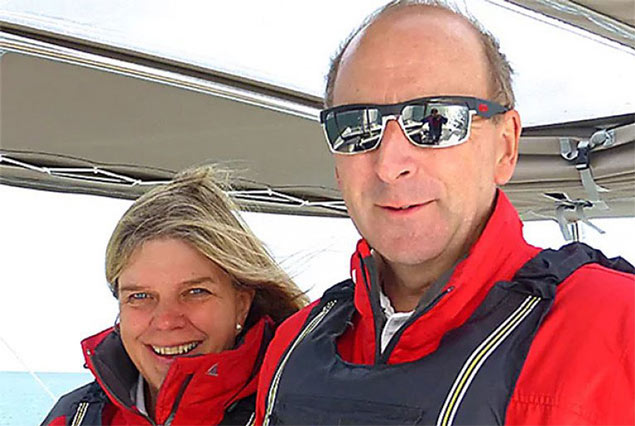 Cathy MacAleavey and husband Con Murphy. Photo: W M Nixon
Cathy MacAleavey and husband Con Murphy. Photo: W M Nixon
We suggested to Cathy that, what with Francois Joyon winning the Route de Rhum the other day at the age of 62, and the incredible Jean-Luc van den Heede leading the Golden Globe at the age of 73 despite rigging problems that would have stopped most people half his age, then maybe she and Con would be game to have a go 36 years after she last was an Olympic sailor, and 31 years after they together established a very long-standing Round Ireland record. The idea certainly wasn’t ruled out of order. That said, maturity isn’t essential for stamina, as 20-year-old Erwan le Draoulec proved when he won the Ministransat a year ago in some style.
Over in France meanwhile, Marcus Hutchinson has been watching it all from the standpoint of someone who is right at the heart of the Figaro Solo circuit (in addition to his involvement with IMOCA 60s), and he reckons that whatever the ultimate plan, at present the only real training and testing programmes available globally are with the Figaro setup, which has already been well used by several Irish sailors, most recently with a potential Mixed Crew in Joan Mulloy and Tom Dolan.
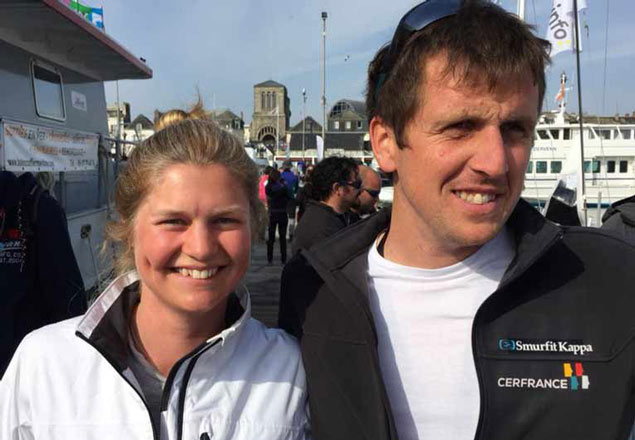 Joan Mulloy of Mayo and Tom Dolan of Meath raced against each other in the 2018 Figaro series. Photo Alex Blackwell
Joan Mulloy of Mayo and Tom Dolan of Meath raced against each other in the 2018 Figaro series. Photo Alex Blackwell
Being France, the 2024 Olympics will have an emphatic Gallic emphasis which has already been in evidence. Back in the Spring of 2018, there had been a scheme hatched up between some sections of World Sailing and the French sailing authorities to trial five different boats – some of them new – to fit this new Olympic event. Although various factors conspired to prevent it happening, the groundwork has been done, and the intention has been fairly clearcut, so it will probably happen soon enough.
Currently, the underlying plan is that the host nation should provide the boats. Thus one line of thinking is that existing classes such as the appropriate craft in the J/Boat range, the Figaro 2, or the Sunfast 3200 and several others could be used as one-designs for training and selection trials in the nations where they are found in significant numbers, and then in 2024 the national winning crews will turn up in Marseilles and this limited edition of brand new boats will be there, ready to go and equally unfamiliar to everyone.
But 2024 is so very far away. Now that the idea of an offshore keelboat has passed through the preliminary stages, the idea of Olympic offshore racing as a sort of reality TV show is going to gain traction, and Paddy Boyd (who is on the World Sailing Oceanic & Offshore Committee) revealed that while the idea that there should be a trial offshore event in tandem with the 2020 Olympics to test the format seemed to have died the death, at the Conference in Sarasota the whisper was that it may yet re-emerge.
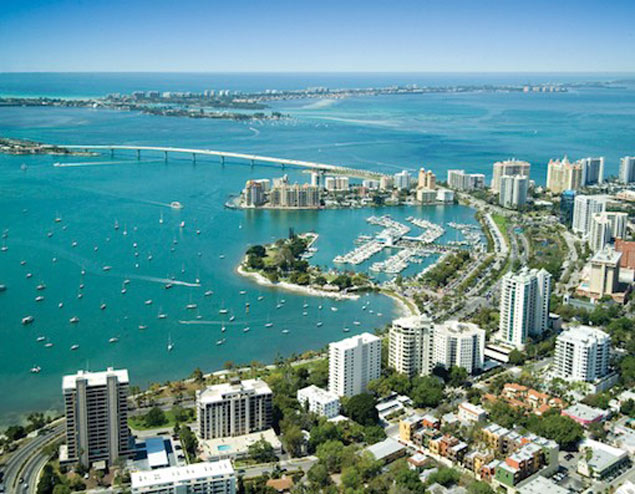 Sarasota, Florida - location for the 2018 World Sailing Conference
Sarasota, Florida - location for the 2018 World Sailing Conference
There’ll be much to-ing and fro-ing before the final decision on boat type for 2024 is made in November 2019’s World Sailing Annual Conference, and by that time it seems quite possible that it will have been agreed that something like a class of Figaro 2s will racing a tandem offshore event at Enoshima on a trial basis.
If it happens, as it looks as though the boats will inevitably be laden down with communications gear, maybe the standard equipment on these proper little offshore racers could also include an air conditioning unit. For the word from Tokyo in July and August 2018 is that that the local climate is so hotly humid as to verge on the putrid. The option of an effective on-board air conditioner could make the trial offshore event the only show in town…….
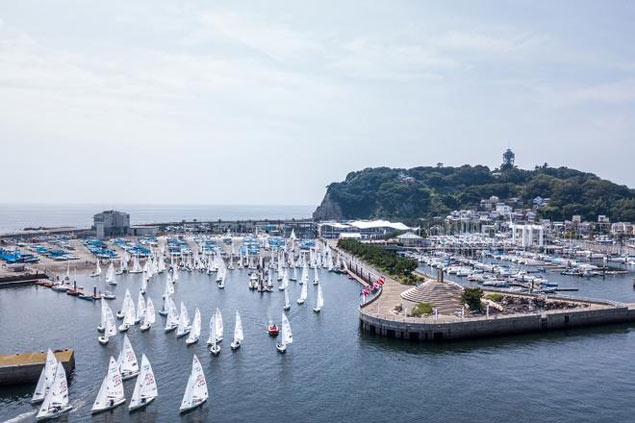 The 2020 Olympic sailing venue at Enoshima near Tokyo. In summer, the intense humidity can be a problem
The 2020 Olympic sailing venue at Enoshima near Tokyo. In summer, the intense humidity can be a problem
Mixed Offshore Event added to Paris 2024 Olympic Sailing Competition
A Mixed Two Person Keelboat Offshore Event will feature at the Paris 2024 Olympic Sailing Competition, providing a new dynamic to the Olympic movement, following ratification at World Sailing's Annual General Meeting.
After a week of meetings, the AGM brought the 2018 Annual Conference to a close as they ratified the decisions made throughout the week.
At the 2018 Mid-Year Meeting in London, Great Britain, World Sailing's Council approved the following slate of Events:
Men's Windsurfer
Women's Windsurfer
New Event, Mixed One-Person Dinghy
New Event, Mixed Two Person Dinghy
New Event, Mixed Kite
They joined the following Events and their Equipment on the Paris 2024 slate:
Men's One Person Dinghy - Laser*
Women's One Person Dinghy - Laser Radial*
Women's Skiff - 49erFX
Men's Skiff - 49er
Mixed Two Person Multihull - Nacra 17
*subject to separate equipment re-evaluation
Although the decision was made, World Sailing's Regulations allowed both the Events and Equipment to be amended if 75% of Council members voted in favour of making the change.
A lengthy debate on replacing the Mixed One-Person Dinghy Event with the Mixed Two Person Keelboat Offshore Event was held before 31 Council members voted in favour of voting on change with eight against and two abstaining. As the 75% minimum was exceeded, Council then voted with 29 members in favour of the Mixed Two Person Keelboat Offshore with nine against and two abstentions.
World Sailing's Member National Authorities have the power to overturn the regulations approved by the Council.
After ratifying numerous regulation amendments over the last 12-months, a debate on reinstating the Mixed One-Person Dinghy event in place of the Mixed Two Person Keelboat Offshore event was held.
Members at the AGM voted with 43 voting in favour of retaining the Mixed Two Person Keelboat Offshore event, 17 were against and four abstained.
This confirmed the slate of Events for Paris 2024 as:
Men's Windsurfer - RS:X*
Women's Windsurfer - RS:X*
Men's One Person Dinghy - Laser*
Women's One Person Dinghy - Laser Radial*
Mixed Kite - TBC
Mixed Two Person Dinghy - TBC
Women's Skiff - 49erFX
Men's Skiff - 49er
Mixed Two Person Multihull - Nacra 17
Mixed Two Person Keelboat Offshore - TBC
*subject to separate equipment re-evaluation
Further decisions related to the Equipment criteria for the Paris 2024 Olympic Sailing Events were also made on the Men's and Women's Windsurfer, the Mixed Two Person Dinghy and the Mixed Two Person Keelboat Offshore.
The RS: X will be the equipment for the Men's and Women's Windsurfer events.The Mixed Kiteboarding event will be on a foiling board with a RAM-Air (foil-kite) and the Mixed Two Person Dinghy event will be a non-foiling displacement boat with a headsail, mainsail and spinnaker.
A displacement monohull (non-foiling) with a shorthanded deck layout will be used for the Mixed Two Person Keelboat Offshore boat. The boat will be between 6-10 metres in hull length, able to perform in 4 to 40 knots with a proper sail inventory for all conditions and be a sloop rig with a spinnaker.
Equipment trials for the Mixed Kiteboarding and Mixed Two Person Keelboat Offshore Events will follow with the decision on the Equipment to be made at the 2019 Annual Conference.
With regards to the Mixed Two Person Dinghy event, selection of the equipment should be based on evaluation against the specified criteria without equipment trials being required. If the evaluation is concluded by the Equipment Committee well ahead of the 2019 Mid-Year Meeting, then Council will be asked to make a decision by electronic vote.
Irish Olympic Sailing HQ Arrives in Dun Laoghaire Harbour
Yesterday saw the long-awaited Irish Olympic Sailing Team plan come to fruition in Dun Laoghaire Harbour when the converted shipping container units, which will house the Irish Sailing Performance HQ Gym, Briefing Room, Lounge and Boat Workshop, arrived on site at the Irish Lights Depot in the south county Dublin harbour.
Over the next few days, the plan is for the containers to be moved into position and furnished while the new Olympic Sailing Team pontoon, as Afloat.ie previously reported, gets the finishing touches alongside them.
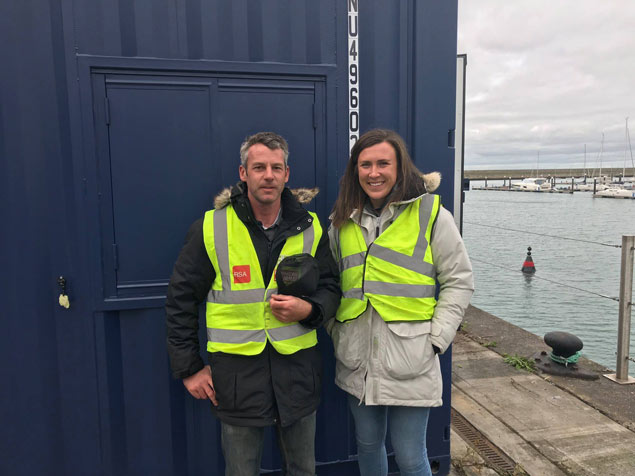 Annalise Murphy and her Olympic coach Rory Fitzpatrick were on site yesterday at Irish Lights, the new home of Irish Olympic sailing
Annalise Murphy and her Olympic coach Rory Fitzpatrick were on site yesterday at Irish Lights, the new home of Irish Olympic sailing
World Sailing Spring Olympic Regatta Date Changes
With two years to Tokyo 2020, Irish Olympic Sailors will be keeping a keen eye on changes to the all-important international calendar following changes to dates announced by World Sailing.
The Spring dates for the World Cup Series Genoa and the Hyéres Regatta, which will follow the Trofeo Princesa Sofia have been revised and are now confirmed for 2019 and 2020.
The events will be held on the following dates:
2019
Trofeo Princesa Sofia, 29 March - 6 April,
Genoa World Cup Series Round, 15-21 April
Hyéres Regatta, 27 April - 4 May
2020
Trofeo Princesa Sofia, 27 March to 4 April
Genoa World Cup Series Round, 13-19 April
Hyéres Regatta, 25 April - 2 May
Genoa, Italy will host its first World Cup Series event in 2019 and the 2020 edition will also act as the European continental qualification regatta for the Tokyo 2020 Olympic Games. Both the 2019 and 2020 editions of World Cup Series Genoa will have open quotas, allowing large fleets to race off the Italian city's dramatic coastline.
Trofeo Princesa Sofia, held in Palma de Mallorca, Spain and the Hyéres Regatta, hosted in the French town, will be ranked 100-point regattas with the Genoa World Cup a 200-point event.
The new dates provide the opportunity for Olympic Class sailors to participate in 3 major regattas in the Mediterranean over a 5-week period.
From 2021, the Hyéres Regatta will return to its traditional timing of the fourth week of April.
On the calendar of events, World Sailing President, Kim Andersen, commented, "The schedule of events enables the world's leading Olympic class sailors an opportunity to test themselves on the road to the Tokyo 2020 Olympic Games.
"The scheduling enables the competitors ample time to travel from venue to venue, prepare on the competitions waters and to compete at a high level. I thank the Fédération Française de Voile and the Federazione Italiana Vela for their close cooperation in confirming the dates for the next two year's."
Francesco Ettorre, President of the FIV said, "I'm very happy that a positive solution has been found, in line with the long-lasting good relationship between the FFVoile and FIV. It is also a great honour to host the Continental Qualifier for the Tokyo 2020 Olympic Games. Now all our focus will go towards providing great racing and the best hospitality and organization for all the sailors."
Nicolas Henard, President of the FFVoile said, "The FFVoile is very happy to be a major part of a great 2019 South European Olympic Tour. As usual, Hyères and Marseille will be ready to welcome the international elite of sailing."
About the World Cup Series
The 2019 World Cup Series commenced in Enoshima, Japan in September. Rounds in Miami, USA and Genoa, Italy will follow in 2019 culminating with the Final in Marseille. Enoshima will host the first round of the 2019-20 series with Miami and Genoa following before a return to Enoshima for the Final as sailors and teams to maximise their opportunity to compete at the Olympic venue and to reduce travel and logistics costs for teams ahead of Tokyo 2020.
The schedule of World Cup events for 2019 - 2020 is:
2019 World Cup
Enoshima Round: 9-16 September 2018
Miami Round: 27 January-3 February 2019
Genoa Round: 15-21 April 2019
Marseille Final: 2-9 June 2019
2020 World Cup
Enoshima Round: 25 August-1 September 2019
Miami Round: 26 January-2 February 2020
Genoa Round: 13-19 April 2020
Enoshima Final: June* 2020
The Olympic Federation of Ireland has welcomed the Government’s announcement that it will increase current funding for Sport Ireland by €6.5m in 2019. The news has also been cautiously welcomed by Irish Sailing's High-Performance Director James O'Callaghan.
Through its National Sports Policy 2019-2017, the Government has committed to doubling funding for sport over the next ten years from €111m to €220m annually, and within that, to a trebling of investment to support elite athletes and their programmes from €11m to €30m per annum over the period.
The details released this week come on the back of €1.5m for High-Performance sport announced by Government earlier this year and will help to provide support for Irish Olympic athletes and their programmes as they prepare for Tokyo 2020 and beyond.
Speaking after the details of the funding increase was announced today, Olympic Federation of Ireland President, Sarah Keane said, “There is a clear correlation between funding for High-Performance Sport and success on the international stage so this additional current funding provided for Sport Ireland is very welcome. The National Sports Policy launched earlier this year provides a solid framework for future success. Today’s announcement demonstrates that the Government is committed to make good on its policy commitments by implementing the first of the increases required over the next ten years. Ireland’s Olympic athletes work incredibly hard to succeed internationally and deserve our support so that they can fulfil their potential.
“The results achieved by our Olympic Sports this summer, and the continuing good performances of our young athletes at the Youth Olympic Games, demonstrate that we can start to deliver consistently with the correct funding and structures in place. This funding announcement is vitally important to address the lost ground caused by the crash of 2008 and to narrow the gap against the support provided in many of the nations which we compete against internationally
“The strong partnerships that now exist between the Olympic Federation of Ireland, Sport Ireland, the NGBs, the athletes and the Sport Ireland Institute means that the system is well set up to capitalise on this investment in the years to come.
“I want to thank Minister Shane Ross and Minister Brendan Griffin for their work through this budget to deliver on the policy’s funding commitments and Minister Paschal Donohoe and An Taoiseach Leo Varadkar for their support.
“We look forward to working closely with Government, the Department of Transport, Tourism and Sport, and Sport Ireland on implementation, and to the many benefits that this investment will deliver.”
James O'Callaghan said: "Broadly has to be seen as positive but we need to see the details to see what it actually means for us [Sailing]"
Irish Sailing Team Need 'More Time on Olympic Waters' as World Cup Series in Enoshima Concludes
There were some mixed results for Irish Sailors in Japan as the World Cup Series in Enoshima, the first major event on Tokyo 2020 Olympic waters, came to a tame finish yesterday. The Irish crews agree it has been a good experience being out on the Olympic racetrack and all four teams have 'learned a lot' in some varied conditions but, says team management, the Irish sailing team will need 'more time here' at the venue over the next two years.
Laser sailor Finn Lynch finished in the top third of his fleet thanks in part to a second scored in race seven. At 17th overall, the National Yacht Club star was the best of the Irish in his 59-boat fleet.
His female counterparts in the Radial division, Aoife Hopkins and Aisling Keller, who are rivals for the single Irish Olympic berth, finished 27th and 37th respectively in their 53-boat fleet. Hopkins of Howth Yacht Club just managed to make the top half of the fleet, her best result being an 11th scored in the seventh and final race of the series.
Team manager James O'Callaghan has rapidly come to the conclusion that the Irish sailors will need to be "all-rounders" to be successful in Enoshima in two year's time.
"At the beginning, we had side effects from a typhoon and some big waves. Then we had sea breeze which got pretty strong. Then we had offshore NE massively shifty flat water, coming off the mountains. We need more time here" O'Callaghan told Afloat.ie. "The Dutch have probably spent the most time here and they got four gold and a silver!" he added.
As Afloat.ie reported previously, the Irish 49er pair Ryan Seaton and Seafra Guilfoyle finished 20 from 27. "Managing to get some solid starts, and continuing to try and work out the other bits!", the pair commented on social media.
Japan strike gold on Tokyo 2020 Waters
Japan’s Keiju Okada and Jumpei Hokazono won gold in the Men’s 470 . The Japanese held an eight-point lead heading into the final day but, due to a light breeze, the fleet were unable to sail, with only the Laser and Laser Radial completing their Medal Races.
Racing was due to commence at 12:00 local time, but the expected sea breeze had not yet developed as cloud covered Sagami Bay. It wasn’t until 15:00 that a 5-6 knot south-westerly breeze developed, allowing the Laser to hit the water. By that time, the 470 Medal Races had been cancelled, handing the Japanese men and Afrodite Kyranakou and Anneloes van Veen (NED) gold.
Elliot Hanson (GBR) won in the Laser the day prior and Marit Bouwmeester (NED) claimed an expectant Laser Radial gold. As the Finn were unable to race, Nicholas Heiner (NED) was confirmed as the victor.
Across the week, Okada and Hokazono sailed with great consistency and as soon as racing was cancelled for the day, they could start their celebrations.
Mat Belcher and Will Ryan (AUS) took silver and Daichi Takayama and Kimihiko Imamura (JPN) completed the podium. Kazuto Doi and Naoya Kimura (JPN) finished in fourth, marking a tremendous regatta for the Japanese team.
Japanese Sailing team leader Aiko Saito said, “We have at least four in the top ten and then we have one or two more. It’s our key class and I am very happy that the boys are doing well. For me, it doesn’t matter who wins, just as long as we are winning.”
Okada and Hokazono are originally from Japan’s southern island, Kyushu, but moved up to Enoshima to target Tokyo 2020. With beaming smiles ahead of the medal ceremony, they commented, “Winning the selection for the Japanese team is very tough but we’ll do the best we can. Winning here in Enoshima gives us an advantage and we are training here more than anyone else, so that’s going to give us confidence for the future.”
The Laser fleet were the first to set sail at 15:17 local time. Elliot Hanson (GBR) held an unassailable 43-point over the fleet going into the Medal Race, ensuring the title was his.
“It’s an amazing feeling to perform so dominantly on the Olympic waters,” said Hanson. “It didn’t sink in how disappointed I was to let my medal slip away at the World Championships in Aarhus until I got home.
“After a bad performance, there’s nothing better than another event to throw yourself into to bounce back, so I was really fired up for this one.”
Jean Baptiste Bernaz (FRA) won the Medal Race but it did not move him onto the podium. Matt Wearn (AUS), finishing in second, benefitted from Thomas Saunders’ (NZL) tenth to move into second spot, and Sam Meech (NZL) completed the medal line up.
Watch the Laser Medal Race back here
Marit Bouwmeester (NED) won the Laser Radial Medal Race to firm up a top spot on the podium which was already all but hers.
Victory in Enoshima confirmed her place at Tokyo 2020 too, as the event acted as a qualification event for the Dutch Laser Radial squad.
“It was pretty challenging with the light winds and offshore breeze so I’m very happy with the result,” said Bouwmeester. “It’s great to secure my spot for the Olympics and now I can focus on putting together the best possible campaign I can. I’m going to try and spend as much time as I can in Enoshima.”
In a light wind Medal Race, Josefin Olsson’s (SWE) second and Emma Plasschaert’s (BEL) fourth ensured there was no movement in silver and bronze respectively.
Click here to watch the Laser Radial Medal Race
Afrodite Kyranakou and Anneloes van Veen (NED) won gold in the Women’s 470 thanks to a consistent week of racing. The Dutch duo narrowly missed out on qualifying their country for Tokyo 2020 at the Hempel Sailing World Championships, but they demonstrated they can perform on Olympic waters.
From eight races sailed, the pair were in the top six in all but one, and finished three points ahead of 2018 World Champions Ai Kondo Yoshida and Miho Yoshioka (JPN). Benedetta di Salle and Alessandra Dubbini (ITA) completed the podium.
“We were really looking forward to having a fight with the Japanese and Italian teams,” said Kyranakou. “They’re pretty good on those conditions so it would have been a good test.
“It’s nice to know we already won but on the other hand it’s very productive to sail on Olympic waters any day.”
“It’s a little bit weird to win and not race but it’s nice,” concluded van Veen.
The Finn hit the water in an attempt to sail their Medal Race, but as the late afternoon breeze started to drop, it became unsuitable for racing.
As the clock ticked down to the 16:30 time limit, expectations were low as a breeze failed to materialise and, bang on time, the Race Committee called an end to a compelling week of racing.
Heiner takes away gold, with Great Britain’s Giles Scott and Ed Wright in second and third respectively.
“It was a great week for me, I was nine points behind at the start and on the back foot,” said Heiner. “I had a really solid week and I’m really happy with the way I sailed. I would have loved to have sailed today but it wouldn’t have been a fair race.
“I’ve raced against most guys a lot this year and this is only the third time I’ve raced against Giles. He’s kind of the unbeatable man and to do that from nine points behind feels good.”
After a packed schedule of events throughout 2018, many of the sailors will now enjoy a period of rest and recuperation before heading to Miami, Florida, USA for the second round of Sailing’s World Cup Series.
Mixed Start for Irish Olympic Sailing Team in 'Shifty' Tokyo 2020 Waters
The National Yacht Club's Finn Lynch was best of the Irish Olympic Sailing Team at the World Cup Series event in Enoshima, Japan yesterday, finishing 28th from 59 boats in the men's Laser class after four races on Tokyo 2020 Olympic waters.
10-20 knot shifty winds and two bad starts made for tricky sailing for the Carlow native.
In the Women's Laser Radial class, Howth's Aoife Hopkins in 34th place leads Lough Derg's Radial National Champion Aisling Keller in 41st in a fleet of 53.
The single Irish 49er of Ryan Seaton and Seafra Guilfoyle lie 19th from 27 after six races sailed.
Full results are here.
As the dust just about settles on the Hempel Sailing World Championships Aarhus 2018, many of the newly-crowned World Champions continue their form at the World Cup Series event in Enoshima, Japan.
The 2018 World Cup Series Enoshima is the first to be held on the Tokyo 2020 Olympic Sailing Competition field of play, and competitors who have succeeded on Olympic waters ahead of the Games often achieve glory come showtime.
Out of the 466 sailors from 44 nations, the World Champions crowned in Aarhus have come to the forefront once again, suggesting that their talents and racing know-how can be seemingly transferred from one venue to the next.
Racing continued at 11:40 today.
Top three by class after day one:
470 Men
1. Keiju Okada / Jumpei Hokazono, JPN, 7 points
2. Naoki Ichino / Takashi Hasegawa, JPN, 10
3. Kevin Peponnet / Jeremie Mion, FRA, 11
470 Women
1. Benedetta Di Salle Alessandra Dubbini, ITA, 7
2. Afrodite Zegers / Anneloes van Veen, NED, 7
3.Elena Berta / Bianca Caruso, ITA, 9
49er Men
1. Dylan Fletcher-Scott / Stuart Bithell, GBR, 3
2. Lukasz Przybytek / Pawel Kolodzinski, POL, 5
3. James Peters / Fynn Sterritt, GBR, 7
49erFX Women
1. Martine Soffiatti Grael / Kahena Kunze, BRA, 3
2. Alexandra Maloney / Molly Meech, NZL, 4
3. Ida Marie Baad Nielsen / Marie Thusgaard Olsen, DEN, 4
Finn Men
1. Giles Scott, GBR, 7
2. Josh Junior, NZL, 8
3. Edward Wright, GBR, 10
Laser Men
1. Michael Beckett, GBR, 10
2. Philipp Buhl, GER, 11
3. Matthew Wearn, AUS, 15
Laser Radial Women
1. Emma Plasschaert, BEL, 8
2. Sarah Douglas, CAN, 12
3. Josefin Olsson, SWE, 16
NACRA 17
1. Ruggero Tita / Caterina Marianna Banti, ITA, 2
2. Vittorio Bissaro / Maelle Frascari, ITA, 4
3. Gemma Jones / Jason Saunders, NZL, 5
RS:X Men
1. Mattia Camboni, ITA, 2
2. Kiran Badloe, NED, 4
3. Pierre Le Coq, FRA, 7
RS:X Women
1. Lilian De Geus, NED, 2
2. Peina Chen, CHN, 4
3. Charline Picon, FRA, 5
Irish Olympic Sailing Team Touches Down at Tokyo 2020 Venue for World Cup Series
An Irish team of three Lasers (two women and one man) and a single 49er pair get their first taste of the Tokyo 2020 Olympic Sailing Competition venue in Enoshima, Japan this week when the harbour will host sailors for the first event of the 2019 World Cup Series.
Following the Hempel Sailing World Championships in Aarhus, Denmark, (where unfortunately Ireland was unable to qualify for Tokyo in any class) the sailors are continuing their journey to the 2020 Olympic Sailing Competition.
Out in Japan representing Ireland are Radial rivals Aoife Hopkins and Aisling Keller (the new Radial Champion), Finn Lynch in the Laser Standard and the Belfast-Cork 49er duo Ryan Seaton and Seafra Guilfoyle.
Enoshima will welcome sailors in just under two years’ time for the Olympic Games and for many, the World Cup will be their first opportunity to learn about the Olympic venue.
Events held on Olympic waters are often strong indicators of what to expect at the Olympic Games.
Annalise Murphy
Following the London 2012 test event in 2011, 17 medallists went on to clinch an Olympic medal, while at the Aquece Rio 2015, Rio 2016’s sailing test event, 16 medallists achieved an Olympic medal a year later.
Of course, as regular readers of Afloat.ie will know, this was not the case for then Radial sailor Annalise Murphy in Rio. The Dubliner had to wait until the cusp of the Games itself when she won a pre-Olympic regatta only weeks before delivering her famous silver medal result, building so magnificently on her fourth overall from London 2012.
Two years later, Murphy is out of the Radial class and heading for a brand new challenge in a double-handed campaign. She is not in Tokyo with new sailing partner Katie Tingle but Belfast Lough organisers say her 49erfx campaign will debut at Ballyholme Yacht Club's 'Speed' event later this month.
The fleets in Enoshima feature many of the leading racers who will be aiming to reign supreme and set a benchmark. Eight of the World Champions crowned in Aarhus are racing and will be joined by more than 450 sailors from 45 nations. More than 30 Olympic medallists are also competing.
Ruggero Tita and Caterina Banti (ITA) have been unbeatable in the Nacra 17 in 2018, winning two World Cup events as well as the World Championships.
In Aarhus, the scene was set for a memorable Medal Race as the Italians led by a narrow margin over Nathan and Haylee Outteridge (AUS), Santiago Lange and Cecilia Carranza Saroli (ARG) and Lin Ea Cenholt and Christian Peter Lübeck (DEN) who were all in contention for gold.
However, a consistent breeze failed to materialise, handing the Italians the world title. The four teams will pick up where they left off in Enoshima, renewing their rivalry in a bid to show who has what it takes on Olympic waters for the first time.
Billy Besson and Marie Riou (FRA) make a return to the World Cup Series, following Riou’s successful adventure on-board Dongfeng Race Team during the Volvo Ocean Race. Besson and Riou were the unprecedented favourites for Rio 2016 gold two years ago, but Besson sustained a back injury that severely impacted his performance. The pair won all four World Championships in the Rio quad and will once again be a team to be feared.
Further contenders in the Nacra 17 fleet include Rio 2016 silver medallists Jason Waterhouse and Lisa Darmanin (AUS), Ben Saxton and Nicola Boniface (GBR), Gemma Jones and Jason Saunders (NZL) and Bora Gulari and Louisa Chafee (USA).
Over the last seven years, Giles Scott (GBR) has raced at 26 international competitions in the Finn. He has won 23 of those, narrowly missing out on gold in the remaining three and settling for silver. After some months off to focus on the British America’s Cup project, he returns to the Finn fleet in Enoshima.
Many of Scott’s victories in recent years have been comprehensive but the 21-boat fleet in Enoshima has significant strength in depth. Jorge Zarif (BRA), Tapio Nirkko (FIN), Jonathan Lobert (FRA), Ed Wright (GBR), Nicholas Heiner (NED), Caleb Paine (USA) and Max Salminen (SWE) all have what it takes to stop Scott in his tracks.
Pavlos Kontides (CYP), 2018 World Champion, will spearhead the 59-boat Laser fleet, the largest in Enoshima. Rio 2016 medallists Tom Burton (AUS), Tonci Stipanovic (CRO) and Sam Meech (NZL) will also sail in the fleet.
Belgium’s newly-crowned Laser Radial World Champion, Emma Plasschaert, will be joined by Rio 2016 gold medallist Marit Bouwmeester (NED) in the 54-boat pack. Both sailors will be vying for the podium, as will Anne-Marie Rindom (DEN), Alison Young (GBR) and Paige Railey (USA).
The Netherlands dominated in the RS:X competition in Aarhus, winning gold in the men’s and women’s fleets. Both Dorian van Rijsselberghe and Lilian de Geus will be in Enoshima with strong competition around them in their respective fleets.
Annemiek Bekkering and Annette Duetz won a third gold for the Netherlands in Aarhus and they will race in the 24-boat 49erFX fleet that also features Rio 2016 gold medallists Martine Grael and Kahena Kunze (BRA). In the 49er, 26-teams will race.
The Men’s and Women’s 470 fleets will feature 32 and 23 teams respectively.
Racing starts at 11:00 local time on Tuesday 11 September. The Men’s and Women’s RS:X, 49er, 49erFX and Nacra 17 competition will conclude on Saturday 15 September with their Medal Races and the Laser, Laser Radial, 470s and Finn will wrap up on Sunday 16.
Dickson & Waddilove Win Under 23 49er World Title
Dublin Skiff sailors Robert Dickson and Sean Waddilove have won the 49er Under–23 Junior World title in Marseille, France.
In a final race climax, the Howth and Skerries pairing won the last race from a chasing pack in the 52-boat fleet.
The duo, both aged 19, who previously topped the 420 class in Ireland before moving up to the Olympic 49er, showed very consistent form during the five-day event on the Cote D'Azur with seven results from nine races in the top five.
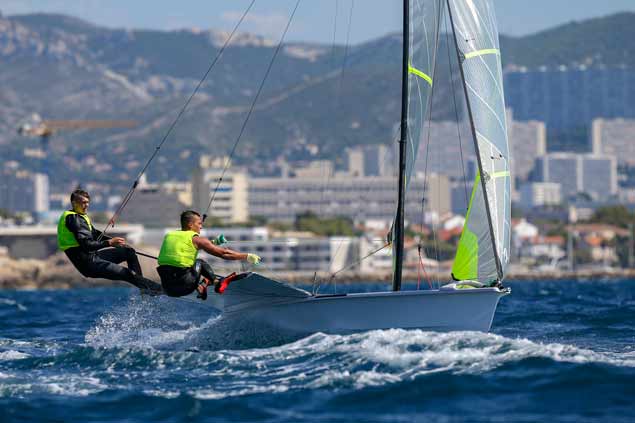 Gold Medal Winners - Robert Dickson and Sean Waddilove in control in big breeze in France Photo: 49er class
Gold Medal Winners - Robert Dickson and Sean Waddilove in control in big breeze in France Photo: 49er class
Dickson and Waddilove went into today’s final round as overnight leaders and really held their nerve despite gear failure in race ten that saw them slip to ninth.
However, they recovered superbly to prevail in the subsequent final race of the series and secure gold, Ireland's first ever win in the skiff class at this age group.
It's all a long way from February 2017 when the pair were down after injury to Waddilove threatened their Tokyo 2020 campaign progress
The win continues a top Irish junior season after Liam Glynn took home a bronze medal in the U21 Laser World Championships in July.
Overall results are here
Additional reportage from 49er.org
The only fleet to get out this afternoon was the 49er Gold Fleet, as the Mistral that has been with us the past three days continued at full strength. Six teams were within eight points of the leader at the start of the final race, so saying it was anyone’s regatta is no understatement!
Robert DICKSON and Seán WADDILOVE (IRL) sealed the victory by winning the last race. The overnight leaders started at the boat, caught the first shift off the cliffs and after a couple more tacks up the beat consolidated and extended in victory to seal the championship.
Locked in a tie after the series, it is Max STINGELE and Linov SCHEEL (GER) that edged out Daniel NYBORG and Sebastian WRIGHT OLSEN (DEN) based on winning the countback on the strength of their gold fleet win in the first race of the day.
The German had the best day on the water, with a 1, 5, and were all smiles after coming back to shore. In between the two races, when it was still unclear if the RC would run a second race or not, skipper Max could be seen physically ramping up his energy level with a series of shouts and leg slaps to be sure hey was up for the occasion. They were not able to replicate their commanding win from the first race, but sailed very well when it mattered most.
Third place is a decent consolation prize for the Danes but they will be kicking themselves for an error in the first race that cost them the championship. In third place down the first run they capsized in their gybe. They weren’t overly under pressure, and they probably make that gybe 7 times out of 10, but not that time.
They were not the only contenders to capsize in the moment, as so did fourth overall’s Bart LAMBRIEX and Scipio HOUTMAN (NED). It took them an age to get the boat back upright, and they could only recover to 15th, a hammer blow since they already had a 19th on their scorecard while the rest of the fleet all had lower discard races.
There were no moments of rest for any of the fleet for the duration of the session. The breeze and seas were right on the limit for the afternoons racing, but ultimately most the gold fleet acquitted themselves nicely in the challenging conditions.



























